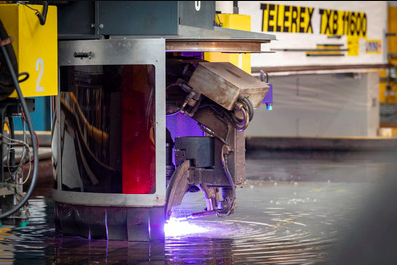
Steel has been cut on the second batch of Type 26 warships, following a £4.2Bn contract awarded to BAE Systems in November 2022.
Minister for Defence Procurement, Alex Chalk KC, marked the occasion at the steel cutting ceremony, with HMS Birmingham becoming the fourth of eight anti-submarine warships being constructed for the Royal Navy at BAE Systems’ shipyard in Govan, Glasgow.
Building on ambitions laid out in the National Shipbuilding Strategy Refresh, this represents another significant milestone for the Type 26 programme, the Royal Navy and UK Defence, reinforcing Defence’s commitment to shipbuilding in Scotland.
With all eight frigates to be built in Govan, and the work sustaining some 1,700 jobs in Scotland with a further 2,300 jobs across the wider UK supply chain, delivering on the Prime Minister’s priority to grow the economy, creating better-paid jobs and opportunity right across the UK.
Minister for Defence Procurement, Alex Chalk KC, said: “This is yet another significant milestone for the Type 26 programme, supporting thousands of jobs in Scotland and across the wider UK supply chain.
“Working closely with our industry partners, we are bringing in a cutting-edge class of warships for the Royal Navy, bolstering our maritime capabilities into the coming decades.”
The frigates will replace the bulk of the retiring Type 23 fleet with its primary role of anti-submarine warfare, protecting the UK’s Continuous At-Sea Deterrent and Maritime Strike Group. The first of the second batch of Type 26 ships, HMS Birmingham will be preceded by HMS Glasgow, HMS Cardiff and HMS Belfast.
At just under 150 metres long, almost the length of three Olympic swimming pools, and with a top speed of more than 26 knots and a range of more than 7,000 nautical miles, the vessels will also be capable of countering piracy and delivering humanitarian aid and disaster relief.
The Type 26 vessels will be armed with the Sea Ceptor missile defence system, able to destroy airborne and sea surface targets. They will also carry a five-inch medium calibre gun, a helicopter, Artisan 997 radar and sonar for navigation and tracking adversaries.
DE&S Director General Ships, Vice Admiral Paul Marshall, said: “The steel cut for HMS Birmingham is a significant moment for everyone who has worked, and is working, on the Type 26 programme to deliver the best possible warships to serve the Royal Navy for decades to come. I look forward to seeing the second batch of frigates taking shape.”
BAE Systems continues to invest in the programme and has submitted a planning application for a new 175 metre long, 85 metre wide, shipbuilding hall at Govan, which will allow two frigates to be built simultaneously under cover. This investment will be a major factor in the final five ships costing less and being delivered in quicker time than the first three.
Construction of all of the city-class frigates is expected to be completed by the mid-2030s, with HMS Glasgow, the first in class, entering service by the end of 2028. Designed for a service life of at least 25 years, the Type 26 frigates will serve in the future Royal Navy surface fleet into the 2060s.
BAE Systems frigate Govan HMS Birmingham National Shipbuilding Strategy Scotland Type 23 Frigate








